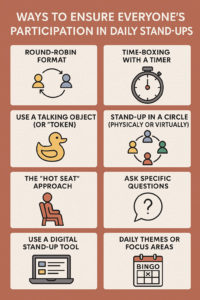Ensuring that everyone participates in a daily stand-up is crucial for team cohesion and effective communication. Here are some strategies to make sure everyone is engaged:
1. Round-Robin Format
-
How it works: Each team member takes turns answering the same set of questions (What did you do yesterda

-
y? What will you do today? Any blockers?). No one is skipped, and everyone has a turn.
-
Why it works: This ensures everyone speaks and prevents certain people from dominating the conversation.
-
2. Time-boxing with a Timer
-
How it works: Set a timer for each person (e.g., 1 minute per person) to keep responses short and on-topic. Use a visual timer (like a stopwatch or countdown timer) to keep everyone mindful of their time.
-
Why it works: It encourages concise answers and ensures that everyone gets a chance to speak without long-winded discussions.
3. Use a Talking Object (or “Token”)
-
How it works: Pass a physical object (e.g., a toy, a ball) to the person currently speaking. Only the person holding the object can speak, and they pass it to the next speaker when done.
-
Why it works: It ensures everyone knows when it’s their turn to speak, helping prevent interruptions and ensuring focus.
4. Stand-Up in a Circle (Physically or Virtually)
-
How it works: Arrange everyone in a circle (or a virtual meeting room). Go around the circle so that everyone speaks in turn.
-
Why it works: This visual structure naturally encourages equal participation, making it easier for everyone to be seen and heard.
5. The “Hot Seat” Approach
-
How it works: Randomly choose one person to start, and then after everyone speaks, the group discusses blockers and challenges as a team. You can rotate the “Hot Seat” to ensure everyone takes a turn.
-
Why it works: This keeps the meeting fresh and dynamic while giving everyone a chance to be in the spotlight.
6. Ask Specific Questions
-
How it works: Instead of general questions like “What did you do yesterday?” ask specific questions like “What challenges are you facing with your task on X feature?” or “Do you need help with Y?”
-
Why it works: Tailoring questions to individual tasks helps people focus and ensures their responses are relevant, which leads to more meaningful participation.
7. Use a Digital Stand-Up Tool
-
How it works: Tools like Slack, Microsoft Teams, or Trello can help organize daily stand-ups. Team members answer the questions asynchronously or during the stand-up using a structured format (e.g., a template for updates).
-
Why it works: It helps introverts or people working in different time zones participate more comfortably. Everyone’s input is visible, and no one gets overlooked.
8. Daily Themes or Focus Areas
-
How it works: Introduce themes to daily stand-ups, such as “Wins Wednesday” where people focus on positive achievements or “Problem-Solving Friday” where they focus on blockers. This creates variety and keeps the team engaged.
-
Why it works: Themes keep the stand-ups from feeling repetitive and encourage everyone to contribute based on the specific theme of the day.
9. “What’s Stopping You?” Segment
-
How it works: After everyone gives their update, hold a quick segment where each person is asked specifically, “What’s stopping you from completing your work?” This focuses attention on blockers and encourages participation in problem-solving.
-
Why it works: Focusing on obstacles ensures that everyone has a chance to share what they need help with, creating a more inclusive and supportive atmosphere.
10. Rotate Facilitators
-
How it works: Have a different team member lead the stand-up each day or week. This shifts the responsibility and keeps everyone engaged.
-
Why it works: It encourages ownership and helps prevent the stand-up from becoming a passive experience for the team members.
11. Gamify the Stand-Up
-
How it works: Introduce light-hearted elements like a “stand-up bingo” with small goals (e.g., “mention a blocker,” “talk about progress on a critical task,” etc.). This adds an element of fun and keeps everyone engaged.
-
Why it works: Gamification can make stand-ups more enjoyable and foster friendly competition, leading to higher participation.
12. Check for Understanding
-
How it works: After each person speaks, ask the team if they have any clarifications or suggestions for that person. This ensures everyone’s contributions are heard and provides a space for interaction.
-
Why it works: It makes the stand-up more interactive, encouraging everyone to engage with the updates and think critically.
Using a combination of these strategies will ensure that your daily stand-ups are more engaging and that everyone participates meaningfully.
